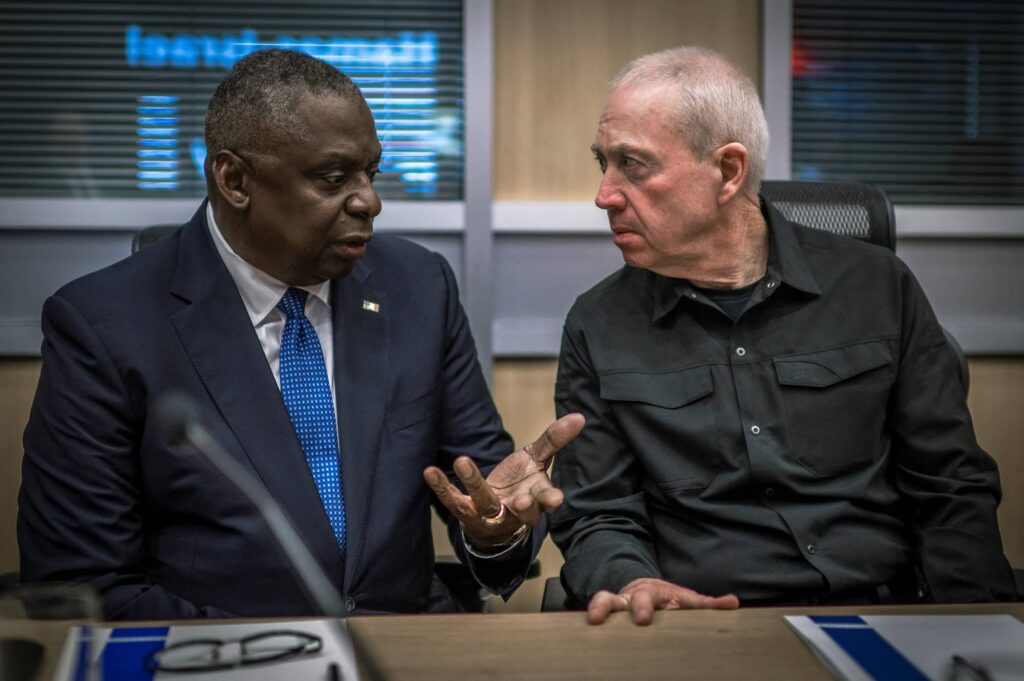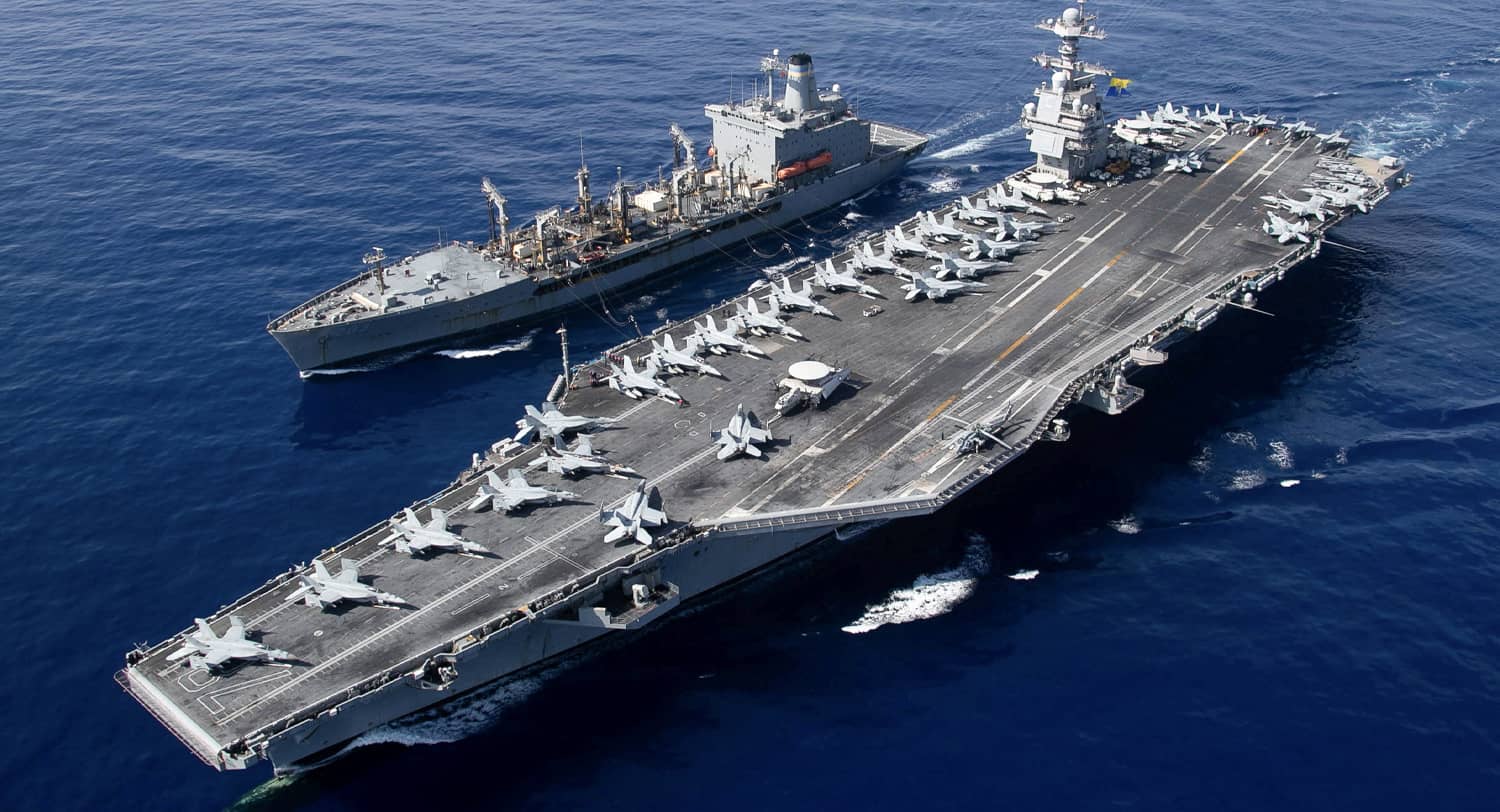While onboard USS Theodore Roosevelt (CVN-71) in 1993, President Bill Clinton opined that when word of a crisis breaks out in Washington, it is no accident that the first question many people ask is: ”Where’s the nearest carrier?”
President Bill Clinton aboard USS Theodore Roosevelt, March 12, 1993
Once again American history repeats itself. In the immediate aftermath of a horrific act that precipitated a declaration of war by Israel on the terrorist group Hamas, the President of the United States searched for options to prevent and deter any further expansion of the crisis. To this end, on October 8 US Secretary of Defense Lloyd Austin ordered the aircraft carrier, USS Gerald R. Ford, to proceed expeditiously to the Eastern Mediterranean theater of operations. The Ford is under operational command of the US Sixth Fleet—my alma mater. It was soon augmented by another carrier strike force, that of the USS Eisenhower – which joined it off the coast of Syria – providing a significant military presence on the eve of President Biden’s visit to Israel on October 18.
Questions may well be raised as to the impact of this deployment on Israel’s traditional commitment to defend itself by itself. There are voices in Israel who worry about an American bear hug, aimed at restraining Israel’s actions against Hamas. But the immediate strategic effect to be achieved by the enhanced American presence is not to detract from Israel’s freedom of action, in response to the horrifying events of 7 October: it is to try and avoid, in close coordination with Israel, the expansion of the conflict (beyond Hezbollah’s ongoing pinprick attacks in the north), leaving Israel to concentrate on its task in Gaza. Whether the American presence, alongside the full positioning of Israeli ground forces in the north, would suffice still remains to be seen. But in order to understand the capabilities involved it is necessary to learn more about the Ford and the abilities the ship brings with it.
On 24 May 2023, I wrote a piece for The MOC—the online journal of the Center for Maritime Strategy of the Navy League of the United States—on the capabilities of this “crown jewel” of the American Fleet. USS Gerald R. Ford’s designation as a “CVN” is important. Let’s deconstruct this—the “C” is for carrier; the “V” is for aircraft; and the “N” is for Ford’s state-of-the-art nuclear propulsion plant. There are three things that make this ship invaluable as a strategic asset to sitting Presidents of the United States—the Sailors who operate this complex warship continuously for up to up to nine months while deployed overseas; the propulsion plant that overcomes the stopping power of water to propel the ship’s 90,000 tons of steel forward at incredible speed; and the variety of combat aircraft onboard that define Ford’s lethality.
USS Gerald R. Ford was on the way to a well-deserved port visit in Marseilles when the ship received the order to head east. When I spoke to the current Commander of Sixth Fleet, VADM Tom Ishee, I asked him about the response of the crew to the new tasking and the cancellation of the port visit. VADM Ishee relayed a conversation with the Carrier Strike Group Commander who relayed that while the sailors had been looking forward to a liberty port, which will surely come later, they now have a renewed sense of purpose with this mission.
USS Gerald R. Ford is the first new U.S. aircraft carrier design in over 40 years. It incorporates 23 new technologies that outmatch and outclass any other carrier in the world. Some pundits criticized the USS Gerald R. Ford’s hefty price tag and schedule setbacks that delayed this ship’s first deployment, but in my view the platform will pay for itself in terms of the preservation of our national security and that of our Allies over the next 50 years of its expected lifetime. USS Gerald R. Ford’s impressive advances to its aircraft launch system, propulsion, power generation, ordnance handling, and more are having a disruptive effect on 21st century warfare at sea.
In fact, in April of this year, the Gerald R. Ford Strike Group successfully completed a composite training unit exercise (COMPTUEX): the certifying event for Navy ships preparing for worldwide combat employment. During the final eight days of intense graded operations, USS Gerald R. Ford (CVN 78) and Carrier Air Wing Eight (CVW-8) met or exceeded all expected standards for a deployable aircraft carrier, validating Ford’s new design and the readiness of her crew.
On 9 October, after Secretary Austin had ordered USS Gerald R. Ford to the Eastern Mediterranean, a Pentagon spokesperson provided a follow-on statement.
The USS Gerald R. Ford Strike Group includes an embarked air wing and accompanying cruisers and destroyers which will conduct maritime and air operations in the Eastern Mediterranean Sea in order to assure allies and partners throughout the region and ensure regional stability.
USS Gerald R. Ford can conduct a variety of missions while on station in the Eastern Mediterranean that include:
- Gaining situational awareness and a common operating picture in an increasingly dangerous neighborhood through the carrier’s organic Intelligence, Surveillance and Reconnaissance (ISR) capability.
- Demonstrating the carrier’s lethality through the visible presence of not only the platform itself, but also her embarked strike fighter squadrons to deter any potential actors who may try to take advantage of this crisis to further exacerbate the situation in Israel and the Gaza strip.
- Conducting humanitarian and disaster relief operations using fixed or rotary wing assets to deliver relief goods ashore and move them around the theater of operations.
Likewise, if MEDEVAC of wounded personnel is necessary, USS Gerald R. Ford has a fully capable Role 2 surgical medical capability embarked. Further medical capabilities would be available aboard the two British Royal Navy assets being sent to the region. - Maritime Domain Awareness (MDA) and Maritime Interdiction Operations (MIO).
- Search and Rescue Operations (SAR).
- Support for Non-Combatant Evacuation Operations (NEO), if called for.
- Hostage Rescue Operations, if necessary.

All of this capability on the carrier was summed up by a Pentagon spokesman as follows:
The versatility and mobility of the strike group, which can conduct a full spectrum of missions, from intelligence collection, maritime dominance, to long-range strike, will ensure the United States is postured to respond to any contingencies and minimize the risk of a wider spread conflict that would threaten stability.
Furthermore, during his press conference with Israeli Defense Minister Yoav Gallant, in Tel Aviv, on 13 October, Secretary Austin offered the following warning:
As President Biden has said, for any country, for any group, for anyone thinking about trying to take advantage of this atrocity, to try to widen the conflict or spill more blood, we have just one word. “Don’t.”
The “don’t” is meant for both state and non-state actors to include Iran, Syrian, and Lebanese Hezbollah, among others. USS Gerald R. Ford and USS Dwight D. Eisenhower are there to help ensure that they don’t.

